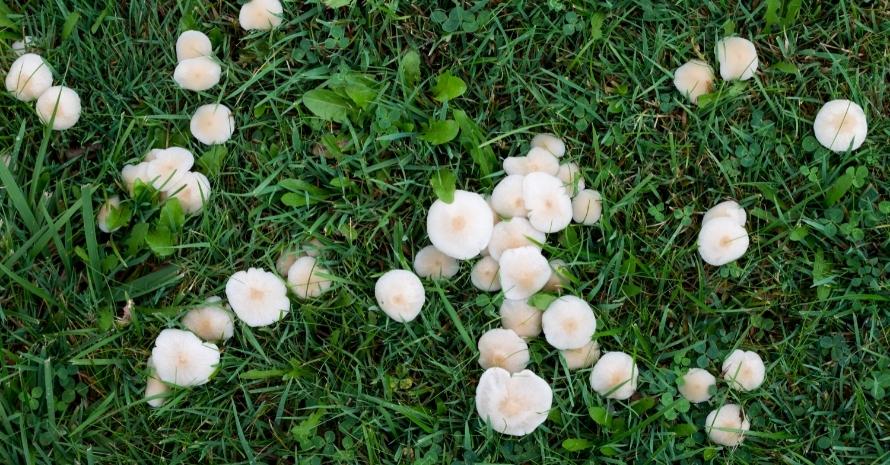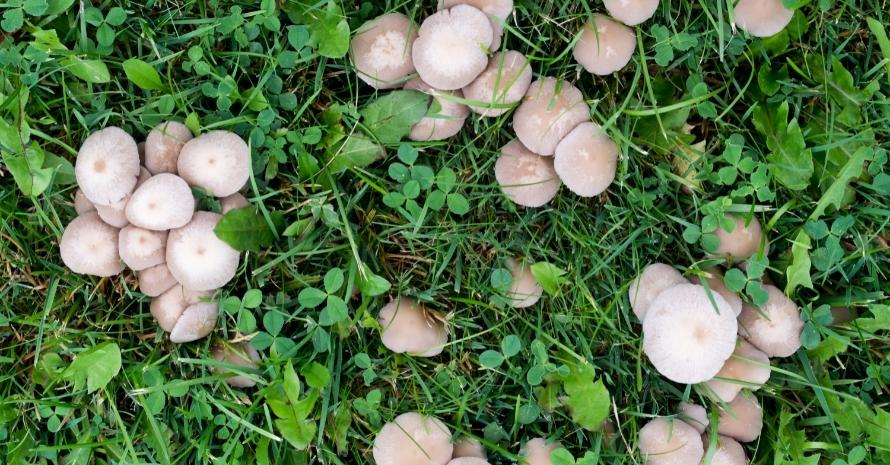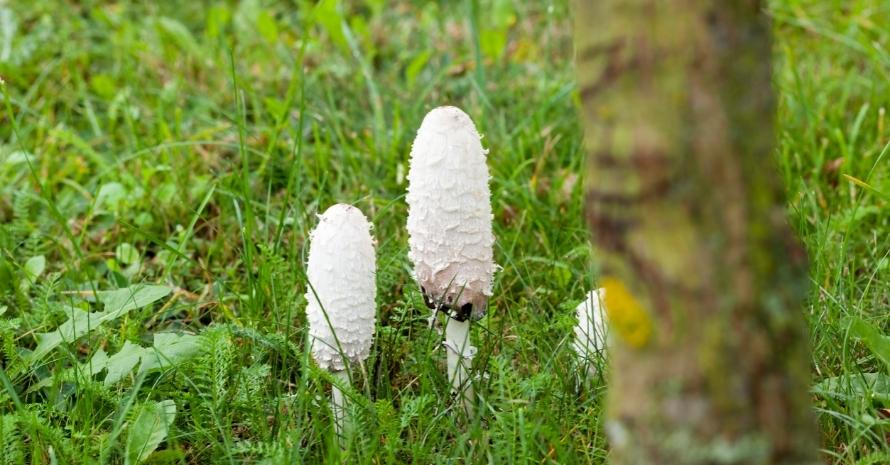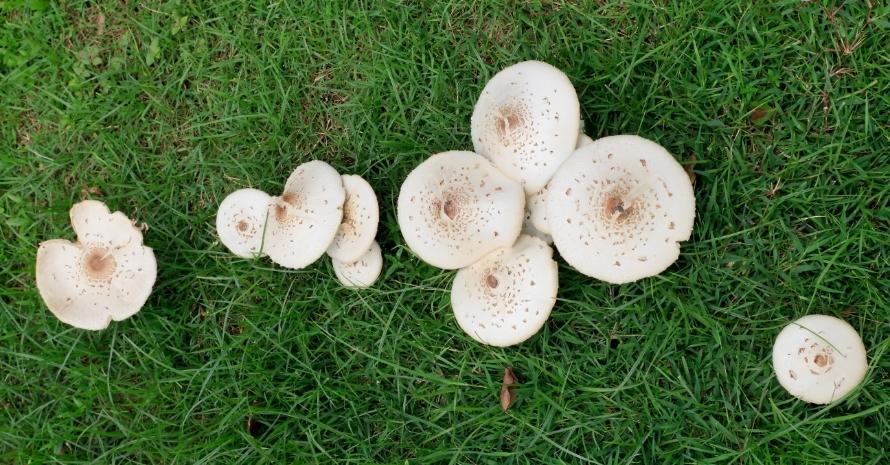Mushrooms are one of the most controversial representatives of the world of nature when it comes to human perception, especially against a neat lawn background. While it’s a widely accepted fact that mushrooms are beneficial to our lawns, we still tend to find them unsightly.
In this article, I’ll share my experience and tips on how to get rid of mushrooms in the lawn in a way that poses no danger to your family. The article comes with an FAQ section to answer your questions about mushrooms that grow in the lawn and how they might harm you or your turf if you do not remove them.
Guide on What Kills Mushrooms in the Lawn
- Consider using a grass-friendly fungicide to kill mushrooms without affecting the lawn;
- Alternatively, you can hand-pick the fungi, which poses the risk of spreading their spores;
- To avoid that, use a bag to collect each mushroom as soon as you pull it out of the ground;
- Avoid overwatering your lawn as a means of prevention.
Why do mushrooms grow in lawns?
If you have ever noticed fungal growth on your property, whether in the form of so-called fairy rings, i.e. mushrooms in a circle in the lawn, or individual mushrooms scattered across the premises, you probably attributed that to wet weather.
This is due to a firm association between mushrooms and increased humidity that has solidified by now, and for a good reason. Indeed, mushrooms rely on available water to thrive even in hot environments. A shady lawn with lush, long grass can be especially welcoming on a rainy day.

It’s during prolonged periods of high humidity that fungi go into a fruition stage, dispersing their spores to reproduce even more. When the conditions become too dry for the above-ground fruiting bodies, they die out on their own. The underground mycelium doesn’t, though, which means the mushrooms will most likely grow back when they have enough moisture.
Should mushrooms be considered a nuisance?
Some homeowners find mushrooms unsightly enough to look for ways to exterminate them, while others admire their quirky beauty but are apprehensive of the potential for toxicity they bear.
Indeed, seeing tall, white, flat-capped mushrooms in the lawn might not be common, but if you have spotted one, you’d better beware. This appearance is characteristic of ripe destroying angels, the much-feared deadly fungi that are accountable for a large percentage of lethal mushroom poisonings across the globe.
Those who make the mistake of eating a destroying angel rarely get the chance to learn from it, but if they do, it is a hard lesson.
If you have children or pets that might nibble on whatever is growing in your backyard, it’s only natural that you are interested in how to stop mushrooms from growing in the lawn. It appears that timing is crucial to fungi management, so be sure to read the section below first.
When to get rid of lawn mushrooms

As soon as the fruiting bodies appear above the ground, they start spreading spores, which serve the purpose of reproduction in fungi. The primary takeaway is that you should not wait for the mushrooms to die out on their own once they have started sprouting unless you are okay with getting even more. The earlier you remove them, the better.
How to get rid of existing mushrooms in your lawn (step-by-step guide)
Chemical control is probably the most popular solution to the mushroom problem because it’s efficient and relatively easy to implement. The market is full of fungicide-based products that will kill fungi in your garden in no time.
The bad news is that most of them will also affect the turf, which is hardly the result you are pursuing. This is why a lot of people are looking for ways in which they can get rid of mushrooms in the lawn naturally. Vinegar, baking soda, and other “natural” chemicals are still chemicals and will likely damage the grass around. Breaking the fungi’s reproductive cycle, however, is an easy and effective solution that’s also associated with little risk.
- Prepare a plastic bag, a small spade, and a spray bottle with a mild soap-and-water solution in it.
- Remember to wear gloves and always wash your hands after dealing with unfamiliar mushrooms to minimize the risk of poisoning.
- Take each mushroom and dig it out as much as you can using the spade. Don’t just pluck the above-ground part; instead, try to go a bit deeper.
- Cut the mushroom and immediately put it into the plastic bag to prevent distribution of spores.
- Spray some soap-in-water solution onto the place where the mushroom used to be as a mild fungicide.
This can be difficult to do in one day if you have a big lawn densely populated with mushrooms, but it will keep the grass alive and poses no risk to your family and pets.
How to prevent mushrooms from growing

Now that you know what causes mushrooms in the lawn, you should have an idea of which parameters you can tweak in order to curb their growth. Here are the most essential tips for preventing fungi from appearing on your lawn:
- Ensure good drainage; regularly check the lawn for signs of flooding and maintain the gutters in order to prevent them from clogging and becoming ineffective;
- Aerate the soil on your property to make sure water can penetrate it rather than accumulate in puddles on top of it;
- Encourage sunlight as much as possible;
- Keep your lawn clean and free of clutter.
Lawn Mushrooms FAQ

In this section, I’m sharing with you the answers to some commonly asked questions about mushrooms that grow on lawns and how to deal with them. Feel free to add your own experience and share your opinion in the comments section down below if you want to make a contribution.
Why am I getting mushrooms in my lawn?
Fungi tend to appear in places that have the right conditions for them, including the presence of water, shade, and organic matter in abundance. Mushrooms feed on nutrients that are found in the soil. Combine a prolonged period of rainy weather and the right amount of organic stuff in the ground, and you will get a lawn that’s particularly welcoming to fungal growths.
Are mushrooms in my lawn dangerous?
They can be. Most mushrooms that grow on lawns are quite harmless, but there are varieties that should be avoided at all costs. You need to be very careful when interacting even with the most innocuous-looking lawn fungi. I definitely don’t recommend eating any mushrooms on your lawn.
How do you kill mushrooms without killing grass?
The easiest way to remove mushrooms without harming the lawn’s overall appearance is to mechanically pull them out and cut the stem with a spade. Remember to wear gloves when doing this and keep a plastic bag nearby because you should wrap the mushrooms up. This way, their spores won’t travel in the air and produce more mushrooms.
Does vinegar kill lawn mushrooms?
It generally does due to high acetic acid content. However, there’s no guarantee it won’t affect the grass in adjacent areas. You also need to wear protective equipment while applying concentrated vinegar to your lawn. Dumping a bucket of vinegar on every mushroom you see is definitely not a way to solve this problem.
Will baking soda kill mushrooms in the lawn?
It will, gradually. Baking soda works by turning the soil alkaline, which is not a favorable condition for fungal growth. However, it takes time. I’d say baking soda is a preventative treatment that you can skip altogether if you keep your lawn dry and sunny.
Don’t Take Chances
Mushrooms aren’t just an eyesore; they are potentially dangerous to little children who can unwittingly eat them and pets. However, exterminating them without damaging the lawn can be a challenge. The most effective solution is to remove them manually in a way that prevents spores from being spread. If you were contemplating a mushroom meal on that day, you’d better not do it!
Which kinds of mushrooms grow on your lawn? Share in the comments.

